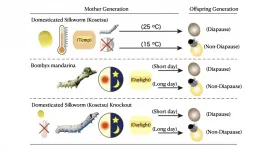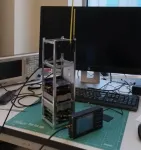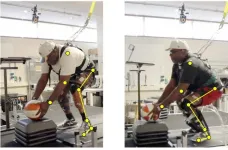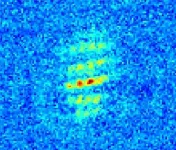Machine learning can help slow down future pandemics
2021-04-13
(Press-News.org) Artificial intelligence could be one of the keys for limiting the spread of infection in future pandemics. In a new study, researchers at the University of Gothenburg have investigated how machine learning can be used to find effective testing methods during epidemic outbreaks, thereby helping to better control the outbreaks.
In the study, the researchers developed a method to improve testing strategies during epidemic outbreaks and with relatively limited information be able to predict which individuals offer the best potential for testing.
"This can be a first step towards society gaining better control of future major outbreaks and reduce the need to shutdown society," says Laura Natali, a doctoral student in physics at the University of Gothenburg and the lead author of the published study.
Machine learning is a type of artificial intelligence and can be described as a mathematical model where computers are trained to learn to see connections and solve problems using different data sets. The researchers used machine learning in a simulation of an epidemic outbreak, where information about the first confirmed cases was used to estimate infections in the rest of the population. Data about the infected individual's network of contacts and other information was used: who they have been in close contact with, where and for how long.
"In the study, the outbreak can quickly be brought under control when the method is used, while random testing leads to uncontrolled spread of the outbreak with many more infected individuals. Under real world conditions, information can be added, such as demographic data, age and health-related conditions, which can improve the method's effectiveness even more. The same method can also be used to prevent reinfections in the population if immunity after the disease is only temporary."
She emphasises that the study is a simulation and that testing with real data is needed to improve the method even more. Therefore, it is too early to use it in the ongoing coronavirus pandemic. At the same time, she sees the research as a first step in being able to implement more targeted initiatives to reduce the spread of infections, since the machine learning-based testing strategy automatically adapts to the specific characteristics of diseases. As an example, she mentions the potential to easily predict if a specific age group should be tested or if a limited geographic area is a risk zone, such as a school, a community or a specific neighbourhood.
"When a large outbreak has begun, it is important to quickly and effectively identify infectious individuals. In random testing, there is a significant risk failing to achieve this, but with a more goal-oriented testing strategy we can find more infected individuals and thereby also gain the necessary information to decrease the spread of infection. We show that machine learning can be used to develop this type of testing strategy," she says.
There are few previous studies that have examined how machine learning can be used in cases of pandemics, particularly with a clear focus on finding the best testing strategies.
"We show that it is possible to use relatively simple and limited information to make predictions of who would be most beneficial to test. This allows better use of available testing resources."
INFORMATION:
Contact:
Laura Natali, doctoral student at the Department of Physics, University of Gothenburg
Phone: +46-(0)76-3121301
Email: laura.natali@physics.gu.se
About the research:
Title: Improving epidemic testing and containment strategies using machine learning
Scientific journal: IOP Machine Learning: Science and Technology
Digital publication: https://iopscience.iop.org/article/10.1088/2632-2153/abf0f7
To develop the method, the researchers used the SIR model to simulate an epidemic outbreak. The model divides the population into three groups: susceptible, infectious and recovered.
[Attachments] See images for this press release:

ELSE PRESS RELEASES FROM THIS DATE:
2021-04-13
Diapause is a phenomenon in which animals and insects foresee changes in the environment and actively reduce metabolism, or halt regular differentiation and development. It is an adaptation strategy for adverse environments such as surviving winters, but also to encourage uniform growth of the generational group. By knocking out genes that allow the silkworm to detect temperature, researchers at Shinshu University et al. found that the silk moth diapause changes from temperature to photoperiod, or day length. This is not only valuable as an elucidation of the molecular mechanism in the environmental response mechanism of organisms such as insects, but also a very important finding in exploring the process of domestication of silk ...
2021-04-13
Scientists from the Skoltech Space Center (SSC) have developed nanosatellite interaction algorithms for scientific measurements using a tetrahedral orbital formation of CubeSats that exchange data and apply interpolation algorithms to create local maps of physical measurements in real time. The study presents an example of geomagnetic field measurement, which shows that these data can be used by other satellites for attitude control and, therefore, provided on a data-as-a-service basis. The research was published in the journal Advances in Space Research.
SSC is the research ...
2021-04-13
Despite increasing concern over the intrusion of algorithms in daily life, people may be more willing to trust a computer program than their fellow humans, especially if a task becomes too challenging, according to new research from data scientists at the University of Georgia.
From choosing the next song on your playlist to choosing the right size pants, people are relying more on the advice of algorithms to help make everyday decisions and streamline their lives.
"Algorithms are able to do a huge number of tasks, and the number of tasks that they are able to do is expanding practically every day," said Eric Bogert, a Ph.D. student in the Terry College of ...
2021-04-13
A recent case study from North Carolina State University and the University of North Carolina at Chapel Hill demonstrates that, with training, neural control of a powered prosthetic ankle can restore a wide range of abilities, including standing on very challenging surfaces and squatting. The researchers are currently working with a larger group of study participants to see how broadly applicable the findings may be.
"This case study shows that it is possible to use these neural control technologies, in which devices respond to electrical signals from a patient's muscles, to help patients using robotic prosthetic ankles move more naturally and intuitively," says Helen Huang, corresponding author of the study. Huang ...
2021-04-13
The immune response to tuberculosis (TB) differs in adults and newborn babies due to the way immune cells use energy to kick into gear in a bid to kill the bacteria. This fresh discovery - just published in leading journal, Frontiers in Immunology - offers hope for improving treatments for what remains a deadly disease.
TB is still one of the biggest infectious killers in the world and babies are more likely than adults to get this infection and for it to spread outside of the lungs. Thanks to the work of scientists in Professor Joseph Keane's TB Immunology lab, based ...
2021-04-13
An observational study of patients in London hospitals suggests that the B.1.1.7. variant is not associated with more severe illness and death, but appears to lead to higher viral load, consistent with emerging evidence that this lineage is more transmissible than the original COVID-19 strain.
A separate observational study using data logged by 37,000 UK users of a self-reporting COVID-19 symptom app found no evidence that B.1.1.7. altered symptoms or likelihood of experiencing long COVID.
Authors of both studies acknowledge that these findings ...
2021-04-13
It has been long been known that cannabis users develop psychosis more often than non-users, but what is still not fully clear is whether cannabis actually causes psychosis and, if so, who is most at risk. A new study published in Translational Psychiatry by researchers at the Centre for Addiction and Mental Health (CAMH) and King's College London helps shed light on both questions. The research shows that while cannabis users had higher rates of psychotic experiences than non-users across the board, the difference was especially pronounced among those with high genetic predisposition to schizophrenia.
"These results are significant because ...
2021-04-13
COLUMBUS, Ohio ¬- New data published by researchers at The Ohio State University Comprehensive Cancer Center - Arthur G. James Cancer Hospital and Richard J. Solove Research Institute (OSUCCC - James) suggests that an oral drug currently used in the clinical setting to treat neuromuscular diseases could also help prevent a common form of skin cancer caused by damage from ultraviolet-B (UVB) radiation from the sun.
While this data was gathered from preclinical studies, senior author Sujit Basu, MD, PhD, says preliminary results in animal models are very promising and worthy of immediate further investigation through phase I human studies. ...
2021-04-13
Studies show wearing masks and social distancing can contain the spread of the COVID-19 virus, but their combined effectiveness is not precisely known.
In Chaos, by AIP Publishing, researchers at New York University Tandon School of Engineering and Politecnico di Torino in Italy developed a network model to study the effects of these two measures on the spread of airborne diseases like COVID-19. The model shows viral outbreaks can be prevented if at least 60% of a population complies with both measures.
"Neither social distancing nor mask wearing alone are likely sufficient to halt the spread of COVID-19, unless almost the entire population adheres to the single measure," author Maurizio Porfiri said. "But if a significant fraction of the ...
2021-04-13
Extremely precise measurements are possible using atom interferometers that employ the wave character of atoms for this purpose. They can thus be used, for example, to measure the gravitational field of the Earth or to detect gravitational waves. A team of scientists from Germany has now managed to successfully perform atom interferometry in space for the first time - on board a sounding rocket. "We have established the technological basis for atom interferometry on board of a sounding rocket and demonstrated that such experiments are not only possible on Earth, but also in space," said Professor Patrick Windpassinger of the Institute of Physics at Johannes Gutenberg University Mainz (JGU), whose team was involved in the investigation. The results of their analyses have been ...
LAST 30 PRESS RELEASES:
[Press-News.org] Machine learning can help slow down future pandemics




